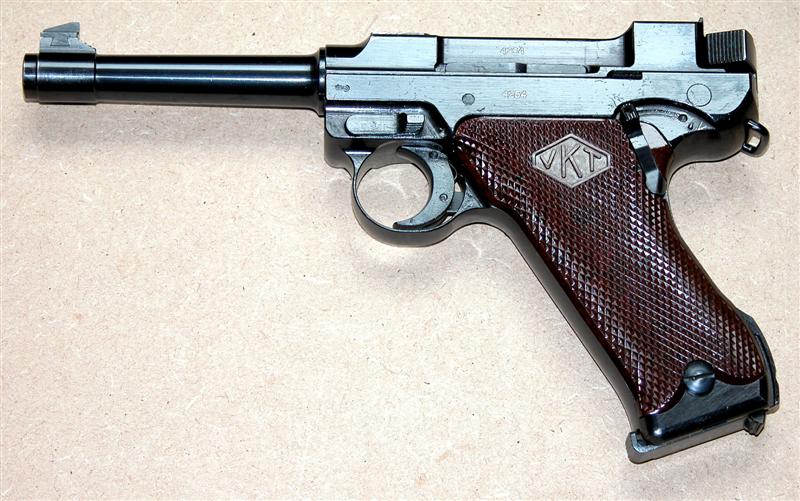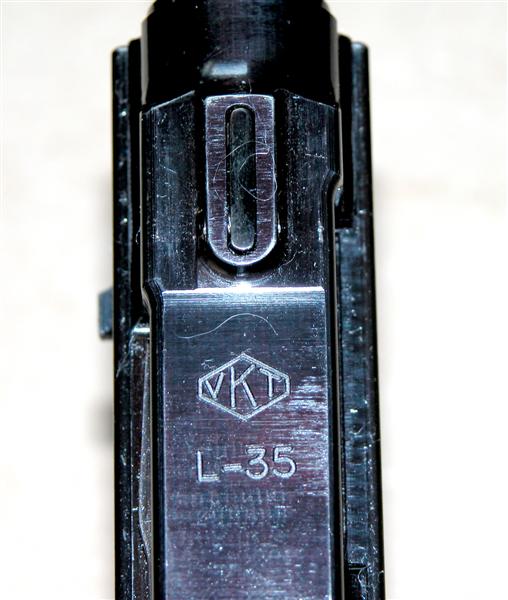
The Finnish pistol Lahti M.35
At the XVIIIe century, Finland was used as battle fields between the Swedes and the Russians. It was yielded by Sweden to Russia in 1809. The tsar made a Grand-Duchy of it.
In 1917, the country was declared independent and under the control of the Mannerheim General, repressed a revolutionary movement. The Finnish forces were equipped with Russian weapons, amongst other things the Nagant revolver.
Between 1919 and 1920, an order of 9000 Ruby pistols to the caliber 7.65 mm Browning placed to France. In 1923 is the Parabellum gun adopted? This model is similar to German P.08, but its barrel is long of 100 mm, confined for the cartridge 7.65 mm Parabellum. 5.000 are delivered to the army and the penitentiary service.
The Finnish government creates in 1926, a national factory of weapons with Jy Väskyla.
An outstanding figure of this company is Almo Johannes Lahti, born on April 28, 1896.
After its studies, it returns to the Finnish railroad, then carries out its military service. It remains in the army in 1926, as arms manufacturer. He submits to his superiors a machine pistol and in collaboration with the Saloranta captain, they develop a light machine-gun, of ordinance in 1926.
Lahti deposits a patent for an automatic pistol on February 16, 1934. A certain quantity was manufactured according to plans of the prototype before being adopted by the army. They are manufactured by Valtion Kivääri Thedas (VKT), as of January 1935. Adopted by the army, the pistol Lahti M.35 replaces the “pistol M.23 Parabellum”. A little heavy compared to the current piostols, L.35 is quite manufactured, its completion is excellent.
Protected particularly well from clogging, it is very sure at the very low temperatures. This weapon has an accelerating device generally applied to the machine-guns to increase the firing speed. This accelerator allows operation well the top of zero degree. It is difficult to entirely dismount this pistol to clean it or repair it without having recourse to a qualified arms manufacturer or the factory. The development of this weapon began in 1929 and the prototype was confined for the cartridge 7.65 mm Parabellum. After several modifications, it was manufactured for the 9 mm Parabellum.
The slope of the stick and the barrel invite to compare this pistol with P.08 Parabellum, the resemblance stops here. The mechanism approaches the Bergmann-Bayard system and uses a rectangular breech moving in the extension of the barrel which forms a closed whole and which is locked by a clamp which moves vertically. The percussion is ensured by an interior hammer. But the great innovation, it is the accelerator of breech incorporated along this one; it is consisted a curved arm which, pushed behind by the recoil of the barrel, sees its force increasing when it turns around its higher end, strikes the breech at a speed higher than that of the barrel moving, communicating a speed high with the breech when it is freed.
The production of L.35 was slow at the beginning. The first 1.000 specimens had plates of handles in beech; the sights were forged with the barrels. Then the plates were delivered out of plastic and the sight was a blade inserted dovetail in the barrel and adjustable laterally. A certain number of sticks out of wooden, kind case stick of shoulder like that of Mauser 96, were manufactured, but ever adopted.
1935 to 1944, it was manufactured 9.000 specimens, 1.000 for the civil ones, 6.000 for the army and 2.000 for Sweden. It was manufactured on the whole 12.000 guns. In 1958, 1.250 pistols were manufactured to honour a contract with the army. They present a longer barrel, like that of Swedish the L.40 gun. Throughout its manufacture, it was improved or simplified: the clamp of blocking to spring and the accelerator were eliminated, the spring between the barrel and its extension was simplified, the indicator of loading was removed, the handle does not comprise more slope of fixing for the stick of shoulder.
Markings are very few on these guns: on the plates of handle are reproduced monogram “VKT” in a rhombus, the serial numbers are struck the left side of the carcass and the extension of the barrel: the numbers with letters “SA” were reserved for the Finnish army (Suomi Armeija). On certain specimens, it was observed the punch of the “Waffen-Amt”: it is possible that they are pistols recovered by the German army.
Design features
Inventor: Lathi Almo-Johannes, arms manufacturer.
Manufacturer: Valtion Kivääritedas (VKT) Jyvaskyla, Finland.
Model: Lawful L35 (Lathi 1935)
Serial number of the studied weapon: 4254
Operation: breech with delayed opening, a bolt ensures the blocking of the back movement assisted by an accelerator of retreat.
Years of manufacture: 1935 to 1944 and in 1958.
Numbers of weapons manufactured: a total of 12000.
Overall length: 239mm.
Thickness: 35 mm
Height: 145 mm
Length of the barrel: 121 mm
Caliber: 9mm Parabellum.
Numbers of stripes: 4 on the right.
Carcass: out of machined steel.
Handle: with two plates out of plastic, bakelite kind, finely squared, maintained with the bottom of the stick by a metal screw.
Construction: three principal elements: the carcass handle with the charger, the mechanism of trigger; the barrel unit - carcass; the mobile breech and its bolt.
Trigger: curved, broad and smooth.
Trigger guard: oval, making block with the carcass.
Striker: striker with interior hammer ensure the percussion.
Charger: removable, for 8 cartridges 9mm Para.
Back sight: fix out of U at the back of the frame.
Sight: blade sloping ahead on dovetail, adjustable transversely.
Line of sight: long of 200mm.
Weight of the empty weapon: 1240 G.
Weight with furnished charger: 1330 G
Protection; bronzed black chechmate.
Safety: safety with lever, placed on the left and at the rear of the frame.
Markings: on the plates of stick: VKT in a rhombus; on the top of the slide,
VKT in a rhombus and L35.
Classification of series: left face, on frame 4254, slide 4254, and the back from the mobile breech, 4254.
Disassembling: remove the charger, take the pistol in the right hand, to support the barrel on a hard surface, when the breech-block is in back position to make swivel the lever of disassembling located above the trigger to release the sets. Leave the sets, barrel and breech-block of the rails of the carcass by the front one. For the reassembly, it is necessary to take care of well replacing the bolt, without him, the weapon can function, but dangerously: premature opening, rupture of the casing, deterioration of the breech, danger to the gunner.
Loading and shooting: seize the shoulders of the breech-block and draw it backwards;
Slacken the breech-block, the spring recuperator will bring the breech-block forwards so that it room a cartridge. When the charger is empty, the breech-block is maintained behind.
Note: arm extremely reliable, of high quality. It is manufactured in the best stainless steels. With the shooting with the target with50 meters, the results are good and regular. Weight of the trigger, 1.750g. Good catch in hand.
Arm heavy, difficult complete disassembling, if one does not have the essential tools.
Max.






